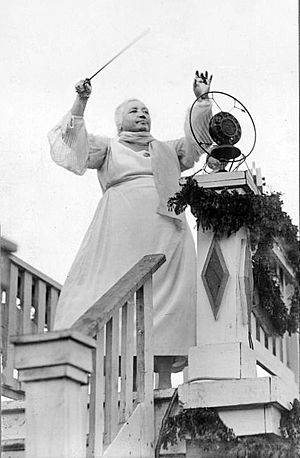Miina Härma facts for kids
Quick facts for kids
Miina Härma
|
|
|---|---|
 |
|
| Born |
Miina Hermann
9 February 1864 Kõrveküla, Kreis Dorpat, Governorate of Livonia, Russian Empire |
| Died | 16 November 1941 (aged 77) Tartu, Estonia (then part of Reichskommissariat Ostland, Nazi Germany) |
Miina Härma was an amazing Estonian composer and musician. She was born Miina Hermann on February 9, 1864, and lived until November 16, 1941. She was one of the first Estonian musicians to get a higher education in music.
Miina Härma did something really special: she brought organ music to people living in the countryside. Before her, most skilled organ players only performed in big towns.
During her long career, which lasted 60 years, she wrote over 200 songs for choirs. She also created many other musical pieces, including a work called "Kalev and Linda". Most of her music was for voices, known as vocal music.
Miina Härma's Early Life
Miina Härma, originally named Miina Hermann, was born in 1864 in a place called Kõrveküla. At that time, it was part of the Russian Empire. Her father was a local teacher, and both of her parents loved music. Miina was one of seven children in her family.
Miina started learning music all by herself. Her father bought her a small organ, and she taught herself to play. When she was 15, she began taking lessons from K. A. Hermann. He taught her how to play the piano and how to compose music.
Studying Music in Russia
In 1883, Miina Härma went to the Saint Petersburg Conservatory to study music. She was the only student that year who chose to study the organ! She finished her studies in 1890.
After graduating, Miina stayed in Saint Petersburg. It was very difficult to find a job as a musician back in her home region of Estonia.
In 1894, a big event called the fifth Estonian Song Festival took place. This festival inspired Miina to start her very own choir.
Moving and Teaching
By 1903, Miina Härma faced some money problems. Because of this, she moved to Kronstadt, another city in Russia. However, she had to leave Kronstadt in 1915. This was because World War I had started, and no regular citizens were allowed to stay there.
Miina then moved to Tartu, a city in Estonia. Even though music was growing popular in Tartu, it was still hard to find a job as a music teacher. The war meant there were hardly any students.
But in 1917, Miina Härma finally became a music teacher at a school. Today, that school is known as the Miina Härma Gymnasium, named after her!
Miina Härma's Legacy
Miina Härma passed away on November 16, 1941, in Tartu. She is buried in the Raadi Cemetery. Her contributions to Estonian music, especially her choral works and bringing organ music to more people, are still remembered and celebrated today.


